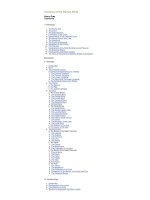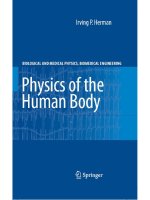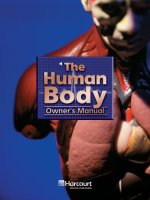Macmillan 09 grade k 02 science the human body
Bạn đang xem bản rút gọn của tài liệu. Xem và tải ngay bản đầy đủ của tài liệu tại đây (29.94 MB, 86 trang )
Copyright © 2009 by The McGraw-Hill Companies, Inc. All rights reserved. Except as permitted
under the United States Copyright Act, no part of this publication may be reproduced or distributed
in any form or by any means, or stored in a database or retrieval system, without prior permission
of the publisher.
Send all inquiries to:
Macmillan/McGraw-Hill
8787 Orion Place
Columbus, OH 43240-4027
ISBN: 978-0-07-288021-7
MHID: 0-02-288021-6
Printed in the United States of America.
1 2 3 4 5 6 7 8 9 10 021 13 12 11 10 09 08
Lesson 1 • Your Body . . . . . . . . . . . . . . . . . . . . .2
Explore Activity: How are faces alike and different? . . .3
History of Science: Discovering X-rays . . . . . . . . . . . . . . 10
Lesson 2 •
Bones and Muscles . . . . . . . . . . . . . 12
Explore Activity: How can you pick up things? . . . . . . 13
Lesson 3 •
Heart and Lungs . . . . . . . . . . . . . . 20
Explore Activity: What is your pulse? . . . . . . . . . . . . . . . 21
Lesson 4 •
Your Stomach . . . . . . . . . . . . . . . . .28
Explore Activity: How does your mouth change
the food you eat? . . . . . . . . . . . . . . . . . . . . . . . . . . . . . . . . 29
Animal Bodies: The Cow Stomach . . . . . . . . . . . . . . . . . 36
Lesson 5 •
Your Senses . . . . . . . . . . . . . . . . . .38
Explore Activity: What is in the bag? . . . . . . . . . . . . . . 39
Science, Technology, and Society: Hearing Aids . . . . 46
Lesson 6 •
Growing and Changing . . . . . . . . 48
Explore Activity: How have you changed? . . . . . . . . . 49
Animal Bodies: Long Lives, Short Lives . . . . . . . . . . . . 56
Lesson 7 •
Eating Healthful Foods . . . . . . . . .58
Explore Activity: What makes a healthful meal? . . . . 59
Careers: Nurses . . . . . . . . . . . . . . . . . . . . . . . . . . . . . . . . . . 66
Lesson 8 •
Staying Healthy and Safe . . . . . . 68
Explore Activity: What things help keep you healthy
or safe? . . . . . . . . . . . . . . . . . . . . . . . . . . . . . . . . . . . . . . . . . 69
Glossary . . . . . . . . . . . . . . . . . . . . . . . . . . . . . . . . . . . . . . . . . . 76
iii
Lesson 1
Your Body
How are all these
children alike? How are
they different?
2
ENGAGE
How are faces alike and
different?
You need
What to Do
Observe. Work with two
classmates. Look closely
at their faces.
crayons
Record Data. Draw a
picture of their faces.
Compare. Share your
drawings with the group.
Discuss how their faces
are alike and different.
Explore More
Communicate. Find
photographs of people
in books or magazines.
How do their faces
compare with yours?
paper
Step
3
EXPLORE
What parts make up
the body?
Vocabulary
system
The body needs many things
to stay alive. It needs food,
water, and air.
The body also must get rid of
wastes. Wastes are things the
body makes but does not
need.
Many parts make up the body.
There are parts on the outside
and the inside. All body parts
work together to keep you
alive and healthy. They help
the body get what it needs.
▲ The body and a toy
clock are made of
parts that work
together.
4
EXPLAIN
What body parts are you using
right now?
Body Parts
head
chest
brain
lung
heart
stomach
arm
intestine
bone
hand
finger
leg
muscle
foot
Read a Diagram
What body parts
are in the chest?
5
EXPLAIN
Body Systems
Each body part does a
different job. Some parts
work only when they are
needed. Other parts work all
the time.
A system is a group of parts
that work together. The
body uses many systems to
meet its needs.
keeping warm
6
EXPLAIN
moving
eating and
drinking
The nose and lungs work in a
body system that takes in air.
The teeth and stomach work
in a system that takes in food.
Bones and muscles work in
systems too.
Classify. List three
things you did
today. Which body
parts helped you
do them?
What do body systems do?
You use many body
systems every day. ▼
breathing
7
EXPLAIN
One of a Kind
Everyone uses the same kinds of
body systems and the same kinds of
parts. But people are different from
one another too.
Everyone is one of a kind! Bodies
come in different colors, sizes, and
shapes. People also think, act, and
feel in many ways.
How are you one of a kind?
▼ Everyone is one of a kind.
8
EXPLAIN
Complete each sentence.
1. Your body is made of many
.
parts
system
2. A group of body parts that
works together is a
.
Answer the questions below.
3. What is one way that body
parts work together?
4. What is one way that all
people are alike? What is
one way they can be
different?
Think of three ways that you
used your body today. Draw
pictures to show each way.
9
EVALUATE
Discovering X-rays
In 1895 Wilhelm Roentgen
discovered the X-ray. The
ray passed through skin
and other soft things. It
did not pass through bone.
hands
spine
Today doctors know how
to read an X-ray picture of
the human body. X-rays
can show damage to
bones, lungs, and other
inside body parts.
10
EXTEND
History of Science
In 1974 the MRI camera
was invented. It can show
better pictures of your
heart, brain, and lungs.
An MRI took this picture
of a human brain.
MRI picture
ultrasound picture
One tool uses sounds
to take pictures.
Sounds made this
picture of a baby
inside the mother.
*6A@j 7DJIj I
How do X-rays help
doctors?
11
EXTEND
Lesson 2
Bones and
Muscles
What can you do with
your arms and hands?
12
ENGAGE
How can you pick up
things?
You need
What to Do
Choose places along your
arm. Try to pick up a ball
at each place. Do not use
other body parts.
Communicate. Draw a
picture of your arm.
Label the places that
could pick up the ball.
Compare. How are
the places that could
pick up the ball alike?
tennis ball
Step
Step
Explore More
Make a model. How
could you build a model
of your arm? Discuss
your ideas.
13
EXPLORE
How does the body move?
Bones are hard parts inside
the body. All together bones
make up the skeleton. The
skeleton allows the body to
stand and move.
Vocabulary
skeleton
joint
muscle
skull
jaw
ribs
arm
bones
Bones come in
different shapes
and sizes. When
children grow, their
bones grow longer
and wider. ▶
spine
leg bones
14
EXPLAIN
Bones also protect the soft parts
of the body. Rib bones in the chest
protect the heart and lungs. The
skull protects the brain.
Bones meet at joints. Joints allow
body parts to bend, turn, or twist.
Together the joints let the body
move in many ways.
How do bones help the body?
Two Joints of the Arm
shoulder joint
elbow joint
Read a Diagram
How are joints alike?
How are they different?
15
EXPLAIN
Muscles
Bones do not move by themselves.
Muscles move the skeleton and
other body parts.
A muscle can tighten or relax. Many
muscles pull on bones to make them
move. Muscles inside the face pull
on skin.
You use more
muscles to
frown than you
use to smile! ▶
16
EXPLAIN
Muscles can pull, but they can
not push. Most muscles work
in pairs. If one muscle pulls a
bone up, a second muscle
pulls it back down.
How do muscles move bones?
Compare. How is
the thumb different
from other fingers?
Compare how they
bend and move.
◀ Two muscles work
together to move
the elbow. One
muscle tightens,
or pulls. The other
muscle relaxes.
17
EXPLAIN
Types of Muscle
The body uses three types of
muscle. They are skeletal,
heart, and smooth muscle.
You can control only skeletal
muscle. Other muscles work
without you ever thinking
about them.
▲ Exercising every day
helps keep all of your
bones and muscles
strong.
What are the three types of
muscle? What do they do?
Three Types of Muscle
Skeletal muscle
moves bones.
18
EXPLAIN
Heart muscle
pumps blood
through the
heart.
Smooth muscle
moves the stomach
and other soft
body parts.
Complete each sentence.
1. All of the bones inside the
body make up the
.
joint
muscles
skeleton
2. Body parts that move bones
are called
.
3. Two bones meet at a
.
Answer the question below.
4. Name three places in the
body where you can find
muscles.
Choose a joint in the body.
Draw a picture that shows
how it moves.
19
EVALUATE
Lesson 3
Heart and Lungs
What body parts work
harder when you play?
20
ENGAGE
What is your pulse?
You need
What to Do
Use one finger to feel the
side of your neck. Feel for
a beating just below the
skin. This beating is called
the pulse.
Press the clay on this spot.
Carefully push one end of
the straw into the clay.
The other end should stick
out straight.
Measure. Have your
partner count the number
of times the straw moves
in one minute.
stop
watch
clay
thin straw
Step
Explore More
Compare. Run in place for
30 seconds. Then repeat
the activity. How did your
pulse change?
21
EXPLORE
What do your heart and
lungs do?
Vocabulary
heart
artery
vein
lungs
diaphragm
Blood brings food, water, and
oxygen to every body part. It
also carries away wastes. The
heart and lungs work together
to help blood do this.
The heart pumps blood
through the body. Its walls
are made of thick muscle.
Pumping Blood
to body
from body
to lungs
from lungs
The heart pumps
blood in a cycle
called a heart
beat. The arrows
show the direction
that blood flows. ▶
from body
22
EXPLAIN
from lungs
to body
The heart contracts, or
squeezes, blood out through
tubes called arteries. Blood
returns to the heart through
tubes called veins.
heart
An artery moves or beats
when blood rushes through it.
This beating is called the
pulse. The pulse tells how fast
or slow the heart is beating.
What job does the heart do?
veins
arteries
Arteries carry blood with
oxygen to every body part.
Then veins carry away
blood with wastes. ▶
23
EXPLAIN









